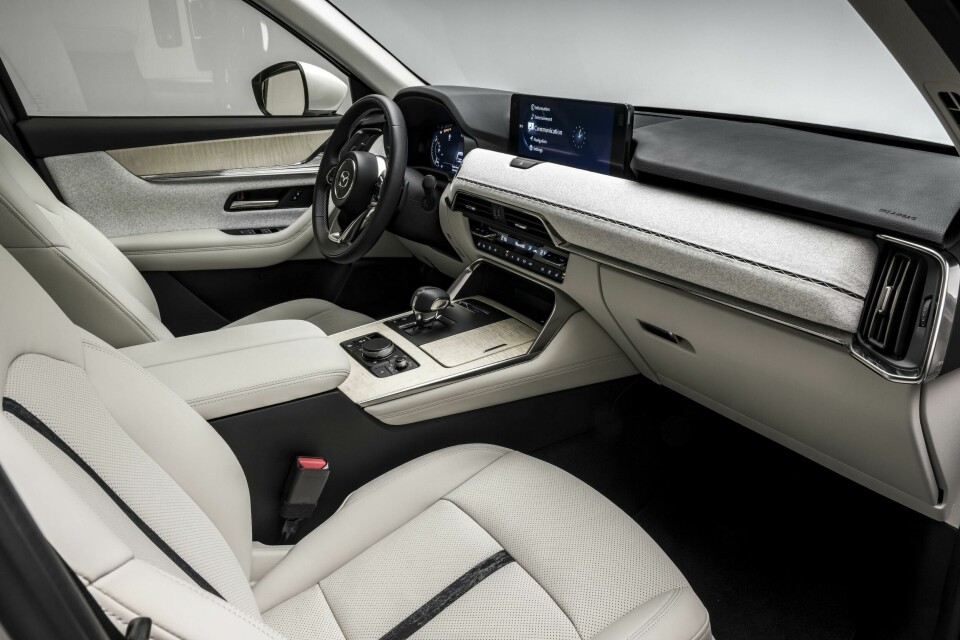
First Sight: Mazda CX-60 signals new platform and interior quality
Japanese maverick brand Mazda launched its new CX-60 SUV in the virtual world, but Car Design News’ Guy Bird got an early sit in its cabin in a secret location in Germany to talk through the production car’s design with Mazda’s European design director Jo Stenuit
To kick things off, a re-cap on where the CX-60 will sit within Mazda’s burgeoning SUV line-up could be instructive, as it’s already a bit confusing and is about to get more so (especially globally). When the CX-60 goes on sale this autumn it will become Mazda’s flagship European and Japanese SUV. The mid-size premium five-seater will offer rear-wheel drive and sit on a new platform that can cater for six-cylinder petrol, diesel, hybrid and plug-in hybrid powertrains and although officially unconfirmed for now, possibly full-electric later as well. Meanwhile, the similar-sized US-only CX-50 that launched late in 2021 will remain as a more off-road, adventure-focused SUV as will the smaller and global CX-5 for more on-road manoeuvres.
Size-wise the CX-60 is 4745mm long, 1890mm wide, 1675mm high (or 1680mm on 20-inch wheels) and with a 2870mm wheelbase. That makes it 37mm longer than BMW X3 and Volvo XC60 rivals (which already uses exactly the same letters and numbers as the CX-60 but helpfully in a slightly different order). A three-row, seven-seat Mazda CX-80 will follow on the same platform a year to so later for Europe and wider-track, US-only versions of the CX-60 and CX-80 rebadged as CX-70 and CX-90 will be announced at a later date. Phew!
Back to the CX-60’s design: straight-six engines longitudinally placed under the bonnet and with rear-wheel drive, means the new model needs and gets a longer nose – 170mm more than the CX-5 – with 45mm more width and a little less height (minus 5-10mm according to wheel size). The CX-60’s front overhang is also shorter than the CX-5’s, its rear overhang longer and it has a bigger wheelbase that allows the CX-60 cabin to be pushed rearward.
“The proportion is the main thing and then it’s detailing, where the window line starts and ends, it’s a collection of details that makes the difference.” Jo Stenuit, Mazda’s European design director told CDN. “For some it may look generic but if you look into the details you discover things that are different.” First impressions, to these eyes – in what is admittedly an incredibly crowded market – is that the CX-60 lacks an obvious exterior unique selling point or visual identifier but when pressed, Stenuit points to the surfacing, crafted by Mazda’s widely-regarded clay modellers. In the right light and up close, especially around the rear three-quarter view, that skill can certainly be discerned and appreciated.
For Stenuit and Mazda it was also important that the CX-60 reflects the wider brand’s national cultural identity – like fellow Japanese brands Nissan and Lexus have been doing for some time. To that end he points to the two-stage-angle black front grille with its thick, interlocking graphic that resembles a Samurai armoured suit. Again look close and the connection is visually valid.
Jump inside the cabin, and this ‘Japanese-ness’ is more convincing still, especially in the delightful open-stitch, horizontal detail that runs across the centre of the dashboard loosely connecting two fabric pieces and highlighted by a darker section beneath the zig-zagged stitched area. Stenuit explains this original automotive detail has another cultural reference point – musubu – which is the Japanese art of binding, often seen in the delicate gift-wrapping from that country. Did the durability engineers have anything to say about including such a complex detail for manufacturing though, as it looks like it could get unpicked by a vigorously errant child left unsupervised in the front seat? “It went through the same tests as the cork in the MX-30,” Stenuit said with a smile. “The Japanese are very meticulous.”
Elsewhere on the display model, shimmering and light-coloured maple wood veneer, tasteful grey marl-style fabric and dark central seat strips with shiny elements, are smartly framed by lighter upholstery either side. All of which genuinely elevates the CX-60’s interior to a more premium market space where Mazda hopes to sell this model. No doubt the wider range of powertrain options this new platform facilitates – including Mazda’s first plug-in – will also help. UK pricing for the plug-in hybrid models has already been announced, ranging from £43,950 to £48,050 and the powertrain is expected to represent a significant two-thirds of the sales mix.














